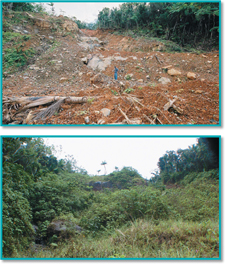Quick Lab
GUIDED INQUIRY
Successful Succession?

Place a handful of dried plant material into a clean jar.
Fill the jar with boiled pond water or sterile spring water. Determine the initial pH of the water with pH paper.
Cover the jar and place it in an area that receives indirect light.
Examine the jar every day for the next few days.
When the water in the jar appears cloudy, prepare microscope slides of water from various levels of the jar. Use a pipette to collect the samples.
Look at the slides under the low-power objective lens of a microscope and record your observations.
Infer Why did you use boiled or sterile water?
Infer Where did the organisms you saw come from?
Draw Conclusions Was ecological succession occurring? Give evidence to support your answer.
Evaluate and Revise Check your results against those of your classmates. Do they agree? How do you explain any differences?
Analyze and Conclude
Climax Communities
 Do ecosystems return to “normal” following a disturbance?
Do ecosystems return to “normal” following a disturbance?
Ecologists used to think that succession in a given area always proceeds through the same stages to produce a specific and stable climax community like the mature spruce and hemlock forest that is developing in Glacier Bay. Recent studies, however, have shown that succession doesn't always follow the same path, and that climax communities are not always uniform and stable.

FIGURE 4–14 Recovery From a Natural Disaster These photos show El Yunque Rain Forest in Puerto Rico, immediately following Tropical Storm Jeanne in September 2004, and then again in May, 2007. Apply Concepts What kind of succession occurred in this rain forest? How do you know?
Succession After Natural Disturbances Natural disturbances are common in many communities. Healthy coral reefs and tropical rain forests recover from storms, as shown in Figure 4–14. Healthy temperate forests and grasslands recover from wildfires.  Secondary succession in healthy ecosystems following natural disturbances often reproduces the original climax community. But detailed studies show that some climax communities are not uniform. Often, they look more like patchwork quilts with areas in varying stages of secondary succession following multiple disturbances that took place at different times. Some climax communities are disturbed so often that they can't really be called stable.
Secondary succession in healthy ecosystems following natural disturbances often reproduces the original climax community. But detailed studies show that some climax communities are not uniform. Often, they look more like patchwork quilts with areas in varying stages of secondary succession following multiple disturbances that took place at different times. Some climax communities are disturbed so often that they can't really be called stable.
 In Your Notebook Describe what causes instability in some climax communities.
In Your Notebook Describe what causes instability in some climax communities.
Table of Contents
- Formulas and Equations
- Applying Formulas and Equations
- Mean, Median, and Mode
- Estimation
- Using Measurements in Calculations
- Effects of Measurement Errors
- Accuracy
- Precision
- Comparing Accuracy and Precision
- Significant Figures
- Calculating With Significant Figures
- Scientific Notation
- Calculating With Scientific Notation
- Dimensional Analysis
- Applying Dimensional Analysis




